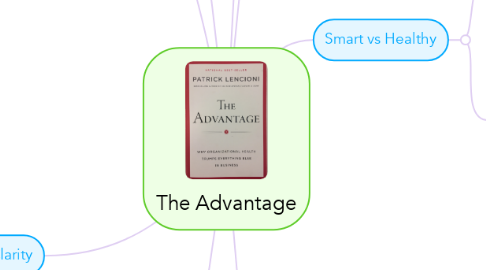
1. Create Clarity
1.1. Question 1
1.1.1. Why do we exist?
1.2. Question 2
1.2.1. How do we behave?
1.3. Question 3
1.3.1. What do we do?
1.4. Question 4
1.4.1. How will we succeed?
1.5. Question 5
1.5.1. What is most important right now?
1.6. Question 6
1.6.1. Who must do what?
2. Over Communicate Clarity
2.1. Repetition
2.2. NOT just transfer of information
2.2.1. Enable Understanding
2.2.2. Enable Internalisation
2.2.3. Enable other to Embrace the Message
2.3. Happens over time
2.4. Happens in a variety of ways
2.5. Comes from different people
2.6. CASCADING Communication
2.6.1. basis of most important communication: gossip - create 'true rumours'
2.6.2. Come out of MEETINGS with clear messages
2.6.3. Communicate what has been decided PROMPTLY
2.6.4. Have direct reports cascade similarly to their reports
2.7. Be
2.7.1. CONSISTENT
2.7.2. TIMELY
2.7.3. REAL TIME
3. Reinforce Clarity
3.1. Make sure the answers to the 6 Question (Create Clarity) are reinforced in every human element of the organisation
3.2. in recruitment
3.3. in management
3.4. in development/training
3.5. in remuneration
3.6. Human systems give an organisation structures for tying together
3.6.1. Operations
3.6.2. Culture
3.6.3. Management
3.6.4. even when the leaders are not around
4. Significance of MEETINGS
4.1. Key activity for maintaining the 4 disciplines
4.2. Healthy organisations have 4 types of meetings
4.2.1. Daily Check-Ins
4.2.1.1. 10 minutes each day check in
4.2.2. Tactical Staff Meetings
4.2.2.1. 2 hours each week
4.2.3. Ad Hoc Topical Meetings
4.2.3.1. 6 hours each month
4.2.4. Quarterly Off-Site Reviews
4.2.4.1. 2 days each quarter
4.3. Four meetings cycles will take 14% of time, leaving 86% time available for doing
5. greatest opportunity for improvement and competitive edge
5.1. attend to root causes of
5.1.1. Dysfunction
5.1.2. politics
5.1.3. confusion
5.2. NOT conventional areas
5.2.1. marketing
5.2.2. Strategy
5.2.3. technology
5.3. Focus on
5.3.1. becoming healthier
5.3.2. tap into existing intelligence
5.3.3. tap into existing expertise
6. Three Biases that stop us doing things to make organisation healthier
6.1. Before leaders can tap into the power of organisational health they must humble themselves and overcome three biases
6.2. Sophistication Bias
6.2.1. Organisational health is so simple leaders do NOT see it as a real opportunity for advantage
6.3. Adrenaline Bias
6.3.1. Takes time to become healthy
6.3.2. Many leaders hooked on rush daily activity and fire fighting
6.3.3. need to slow down to go fast
6.4. Quantification Bias
6.4.1. difficult to quantify the benefits and measure
7. Smart vs Healthy
7.1. Smart is common approach - it is science
7.1.1. Marketing
7.1.2. Finance
7.1.3. Strategy
7.1.4. Technology
7.2. Healthy disciplines are less common
7.2.1. Build cohesive leadership
7.2.1.1. those running the organisation must be behaviourally cohesive in 5 ways
7.2.2. Create clarity
7.2.2.1. leaders aligned and committed to the SAME answers to 6 questions
7.2.3. Over communicate clarity
7.2.4. Reinforce clarity
8. Build A Cohesive Leadership Team
8.1. Behaviour 1
8.1.1. Building trust
8.1.1.1. Vulnerability based trust
8.1.1.2. Comfortable being transparent and honest
8.1.1.3. I screwed up, I need help, support, I'm sorry
8.1.1.4. Abandon pride and fear
8.1.1.5. Sacrifice egos
8.2. Behaviour 2
8.2.1. Mastering Conflict
8.2.1.1. Conflict is not bad for a team
8.2.1.2. Fear of conflict is sign of problems
8.2.1.3. Mine for conflict in meetings
8.2.1.3.1. unearth disagreement and demand people come clean
8.2.1.4. If conflict not resolved
8.2.1.4.1. people leave discussion and do nothing
8.3. Behaviour 3
8.3.1. Achieving Commitment
8.3.1.1. Conflict is important because a team cannot achieve commitment without it
8.3.1.2. People will actively have to commit to a decision (course of action)
8.3.1.2.1. Can only do so when full rationale been understood
8.3.1.3. Passive agreement is common
8.3.1.3.1. everyone nods and go back to work and do as little as possible to support the idea or action
8.4. Behaviour 4
8.4.1. Embracing Accountability
8.4.1.1. necessary if going to stick to decisions and achieve goals
8.4.1.2. peer-to-peer is the most effective source of accountability
8.4.1.3. Have to be able to confront issues without fearing defensiveness or backlash
8.4.1.4. questioning and honest answers enable performance
8.5. Behaviour 5
8.5.1. Focusing on Results
8.5.1.1. Too many leaders have affinity and loyalty to their part of the organisation instead of achieving the result for the organisation as a whole
8.5.1.2. Be clear which team is the leaders' priority
8.5.1.3. Put the needs of the higher team above their own
8.5.1.4. Leads to good decision for the whole
